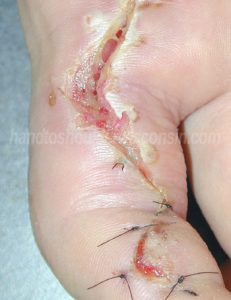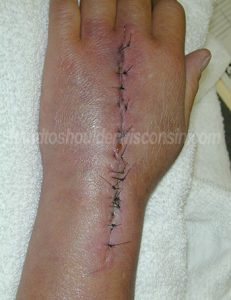If you believe you are experiencing signs of a hand or finger infection, including swelling and redness, drainage or pus, severe pain, or stiffness and fever, contact Hand to Shoulder Center of Wisconsin in Appleton or Green Bay, WI. Our team of orthopedic specialists have experience diagnosing finger and hand infections, and are here to provide you with treatment options.
Finger Infections (Felon, Paronychial and Tendon Sheath Infections)
An infection is caused when another organism (bacteria) gets inside the body and reproduces. The organism is often referred to as a parasitic organism or an infectious agent. Most organisms enter into the body through open wounds. Since the hand can easily be injured during everyday activities, any trauma involving an open wound allows damaging organisms to enter. The anatomy of the hand also may aid in the development of an infection with its compartmentalized structure.
Hand and/or finger infection (Fig.1) can cause mild to severe problems even after the infection has been resolved. Stiffness, loss of strength and tissue can be affected by the infection. However, if treated early and effectively, most infections can be eliminated with antibiotics, rest, elevation, and other non-operative actions. Failure to properly treat infections may result in permanent disability or even loss of the digit.

Figure 1: Infected Finger
Symptoms of an Infection
Symptoms of an infection may include:
- Pain and/or severe throbbing pain
- Low to high grade fever
- Stiffness with movement that may produce excruciating pain
- Swelling and redness
- Drainage or pus
At Hand to Shoulder Center of Wisconsin, we provide comprehensive treatment for common infections of the upper extremity, including treatment of but not limited to:
- Paronychia – an infection of the finger that involves the tissue at the nail’s fold; primarily caused by a bacterial infection.
- Felon – an infection of the soft tissue in the fingertip pad.
- Cellulitis – this is a superficial infection that involves the skin and underlying tissue.
- Tendon sheath infection (Fig. 2) – an infection that involves the tendon sheaths that are responsible for flexing or closing the hand.
- Bite wound – harmful bacteria can be found in the mouth of an animal or human causing an infection to develop.
- Deep space infection – typically a severe infection of one or several deep structures of the hand or fingers that require surgical drainage.

Figure 2: Tendon sheath infection
Diagnosis and Treatment
At Hand to Shoulder Center of Wisconsin, our subspecialty-trained orthopedic surgeons conduct a thorough examination. Review of medical history is discussed along with a physical and visual evaluation.
In treating an infection (Fig. 3), it will depend on the degree of the infection; some early infections can be managed with oral antibiotics, while others may require intravenous antibiotics in a hospital setting.

Figure 3: Inflamed and infected finger
In treating an infection with drainage the physician may order an x-ray to determine if a foreign body is present. If a foreign body is present, steps to surgically remove it are often taken. A small incision is made, the wound is flushed out to remove debris and infected material. The material is often sent to a laboratory for testing to determine the type of bacteria causing the infection. Antibiotics are prescribed and postoperative monitoring is conducted by the physician. In some cases, the infection may spread to other areas of the body, which can ultimately result in amputation of the body part, or death, if not treated by a physician in a timely manner. It is highly important that wound infections are treated with proper care. In some cases of severe infection, intravenous antibiotics may be given to combat severe blood infection (sepsis).
Rehabilitation
A physical or occupational therapist will perform hands-on techniques to aid in decreasing and relieving pain while focusing on restoring pain-free range of motion. Muscle strengthening and decreasing stress on the joints by using braces and splints may be applied. Modalities such as ultrasound and heat/ice are often used to help control pain, facilitate motion and control swelling. Early rehabilitation treatment protocols include a home exercise program to encourage range of motion and restoring functional use of the hand.